|

Great engineering feats III
Ancient and modern tanks
The hydraulic civilisation of our country is a great pride to us. We
have to be grateful to the kings who ruled the country and also our
highly skilled ancestors for leaving behind such a remarkable heritage.
Many of you may have seen the mighty tanks and reservoirs that dot the
country and been fascinated by the expertise displayed by our ancient
tank builders. Apart from the numerous massive tanks built by our
ancient kings many new reservoirs have also been built during modern
times and these are as impressive as the ones constructed in the past.In
the last two weeks we featured some of these tanks and today too we
continue the series featuring a few ancient and modern tanks that have
become the lifeline of farmers.
Some of these massive tanks also supplement the hydro power capacity
in the country. These engineering marvels are important places that you
must learn about and if possible visit as they play a key role in the
agriculture and economic development of the country.
**********
Maduru Oya Reservoir
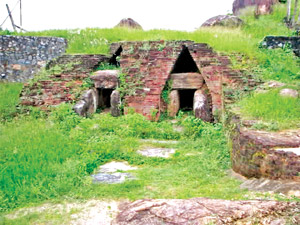 It
is the first major project (1978) taken up for construction under the
Acceleratedf Mahaweli Development Programme straddling the Maduru Oya . It
is the first major project (1978) taken up for construction under the
Acceleratedf Mahaweli Development Programme straddling the Maduru Oya .
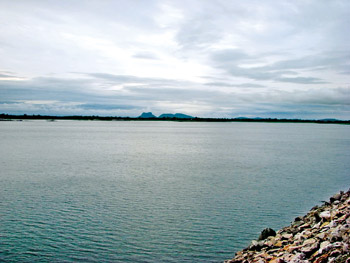 This
reservoir is of great significance because a masterpiece of irrigation
construction,an ancient sluice on the old ruptured earthen bund of the
Maduru Oya, was discovered at the very location surveyed and calculated
by the local and foreign irrigation engineering experts to build this
new dam in 1981. This
reservoir is of great significance because a masterpiece of irrigation
construction,an ancient sluice on the old ruptured earthen bund of the
Maduru Oya, was discovered at the very location surveyed and calculated
by the local and foreign irrigation engineering experts to build this
new dam in 1981.
The ancient earthen dam and sluice built during the reign of King
Mahasena (275-301 B.C.) made up of stone slabs and bricks, is about 30
feet (9.1 m) high, 30 feet (9.1 m) wide and 219 feet (67 m) long.
The upper sluice was built in two phases, the first of which dates to
before the 6th century BC.
The lower sluice is believed to be older than that.Many marvelled at
this discovery as it proved that the ancient engineers of our land were
very knowledgeable and highly skilled.Modern western engineering had
just managed to match the ancient hydraulic engineering of Sri
Lanka.This made many realise that our ancient Sinhalese irrigation
engineering and the hydraulic civilisation of Sri Lanka,has been second
to none.
The Maduru Oya has its source to the North-east of Central Highlands
of Sri Lanka at Uva hills east of Bibile at an elevation of 274 m. (900
ft.) above sea level.
It flows north-eastwards covering a distance of about 136 km. and
disgorges into the Vandaloos bay near lovely beaches of Kalkudah and
Passikudha on the east coast.
Features
Catchment area :453 Sq.km
Length and height:1090 m and 43 m
Capacity:597 million cu.m
**********
Tissa Wewa
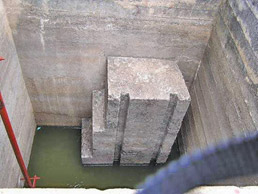 This
massive tank which was built by King Devanampiya Tissa ( 250-210 BC) is
located in north central Sri Lanka, near the city of Anuradhapura, in
the dry zone. This
massive tank which was built by King Devanampiya Tissa ( 250-210 BC) is
located in north central Sri Lanka, near the city of Anuradhapura, in
the dry zone.
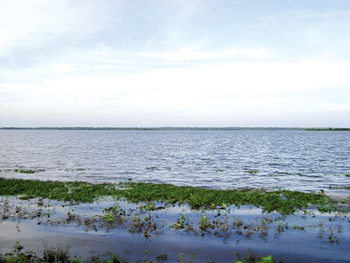 The
terrain is very flat.It has an area of approximately 550 acres and the
width of the top of the reservoir was found to be 12 feet to 18 feet.
Only Panda Wewa and Abhaya Wewa are considered to be older than Tissa
Wewa. The
terrain is very flat.It has an area of approximately 550 acres and the
width of the top of the reservoir was found to be 12 feet to 18 feet.
Only Panda Wewa and Abhaya Wewa are considered to be older than Tissa
Wewa.
Parker in 1909 reports that the embankment appears to be in original
state ( that of 1100 years ago) and its so solidly built, with little
maintenance this bund will last forever.
Just as he commented, the Tissa Wewa continues to provide water to
the Anuradhapura even today.In 1887 the Tissa Wewa too had been
rehabilitated by the British .
The water in the tank is used for irrigation, drinking water,
washing,and daily and recreational bathing.It is said that in the time
of the kings,Tissa Wewa fed two rock cut stone bathing pools in Ranmasu
Uyana. Brick-topped granite channels direct water along the base of the
bund, divert it through silt traps, and pour it into the embedded tiers
of the pools.
Features
Catchment area: 6.5 Sq.km
Length and height: 3480 m and 11m
Capacity: 4.3 million cu.m
**********
Chandrika Wewa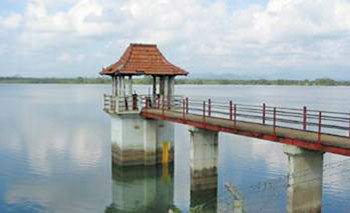
Chandrika Wewa which holds a unique position among the major
irrigation constructions in the Walawe Basin is entirely a contempory
irrigation construction. Due to the Chandrika Wewa Agricultural Colony
Project it was possible to settle a large number of people in the Walawe
basin which recorded very few people in the 1960s. Pulanda Oya, a
tributary to the Walawe River was blocked with a 2500m long bund to
build this reservoir.Currently there is a water management system which
links Thunkama, Angunukolapalassa,Binkama, Muraweduihena and
Basawakkaulama to Chandrika Wewa.
In addition to that it provides potable water for the people of the
area.
Features
Catchment area : 203 Sq.km
Length and height: 2500 m and 19 m
Capacity: 27 million cu.m
**********
Kaudulla Wewa
King Mahasena is credited with the constuction of this great wewa
which is also identified as the 'Thissawaddamana Vapi' or'Ranthisa Wewa'.
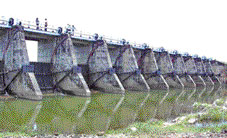 Acccording
to the chronicles, both King Vijayabahu (1055-1110) and King
Parakramabahu the Great, (1153-1186) respectively had carried out
rehabilitation work on the tank which was formed by building a bund
across Kaudulu Oya. Acccording
to the chronicles, both King Vijayabahu (1055-1110) and King
Parakramabahu the Great, (1153-1186) respectively had carried out
rehabilitation work on the tank which was formed by building a bund
across Kaudulu Oya.
It receives water along the Elahera-Kantale Giant Canal which begins
at Elahera Anicut on Amban Ganga, built by King Vasabha.Gal Oya and
Aluth Oya are two natural water reservoirs located in Kaudulla Wewa.
Features
Catchment area :348 Sq.km
Length and height:9234 m and 15 m
Capacity:64 million cu.m
**********
Nuwara Wewa
The largest of the three man-made reservoirs in Anuradhapura it is
believed to have been built by King Vattagamini Abaya popularly known as
King Valagamba in the first century BC.
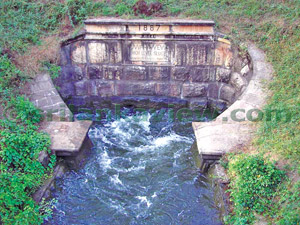
A massive dam had been built across the Malwathu Oya to divert water
to this tank which covers an area of 3180 hectares.
From the dam a 40 feet wide channel has been cut to bring the water
to the Nuwara Wewa.
The canal has a depth of about four feet. At about 150 feet from the
dam, a flood escape had been built to divert the excess water back to
the river.
The bricks used to construct the wewa are believed to be similar to
those used in the famous Abayagiriya Stupa and going by this H.Parker
claims in his book Ancient Ceylon that the tank may have been
constructed in the first 20 years of the 1st century BC.
In 1873 nearly all these rocks had been removed to be used to erect a
road bridge across the river.Restoration work on the wewa had been
carried out in 1890 by the British.
Features
Catchment area: 51 Sq.km
Length and height: 6500m and 11m
Capacity: 44 million cu.m
**********
Usagala-Siyambalagamuwa Wewa
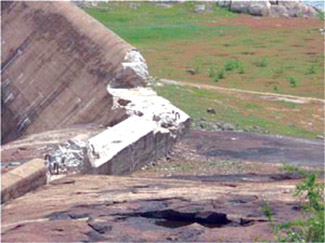 This
ancient irrigation scheme which is located in the Kala Oya basin is said
to be yet another remarkable construction by King Mahasena (276-303). This
ancient irrigation scheme which is located in the Kala Oya basin is said
to be yet another remarkable construction by King Mahasena (276-303).
According to historians, King Mahinda II (777-797) had built a 16
miles long feeder canal from Kala Wewa to supply water to
Usagala-Siyambalagamuwa. The ancient chronicle the Mahawamsa says King
Buwanekabahu (1534-1542) also rehabilitated it and cultivated 500 amunu
(750 acres) of paddy.
The first colonial report of this site was published in 1877. The
rehabilitation work carried out by Irrigation Department saw its
completion when it was filled in 1955.
Features
Catchment area :184 Sq.km
Length and height:1433 m and 4 m
Capacity: 27 million cu.m |

